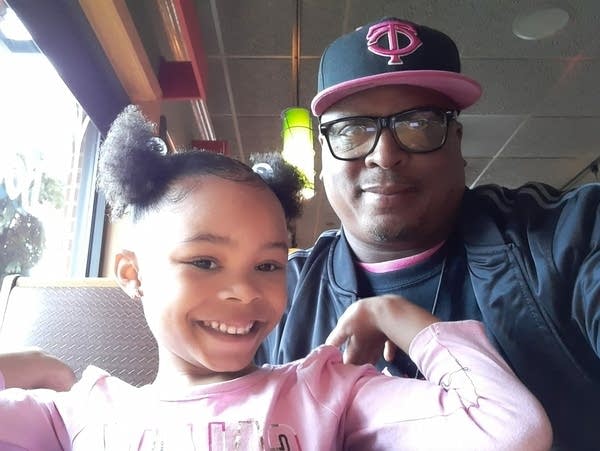When gun violence soars, stray bullets claim young lives in Minneapolis

Go Deeper.
Create an account or log in to save stories.
Like this?
Thanks for liking this story! We have added it to a list of your favorite stories.
When K.G. Wilson stood outside of a Minneapolis hospital the day his granddaughter was pronounced dead, he expressed grief, sadness and anger. The longtime peace activist is typically the one consoling families of gunshot victims. Now he found himself in their shoes, helpless and in need of support, as he called on the killer of his 6-year-old granddaughter to turn themself in.
“You murdered our loved one — a 6-year-old baby, a precious little girl,” he said. “You murdered her. I don’t know who you are or where you’re at, but I hope you're watching this.”
Weeks later, the killer of Aniya Allen remains free as police continue to investigate the case. And the number of homicides in urban cities across the country, including Minneapolis, is on the rise. It includes children like Aniya, who was riding in the back seat of her mother’s car eating a Happy Meal when she was fatally shot.
These recent killings of children in Minneapolis have renewed calls for stricter gun laws and violence prevention efforts. With warmer months come the risk of even more bloodshed and the fear that additional innocent bystanders will be hurt.
Turn Up Your Support
MPR News helps you turn down the noise and build shared understanding. Turn up your support for this public resource and keep trusted journalism accessible to all.
“It is so sad, but it’s almost normal,” said Farji Shaheer, a community engagement specialist who runs a program called Next Step at HCMC and North Memorial Hospital. “Right now we have an emotional, hostile, just toxic situation occurring in our city, and that is just based upon individuals’ pride and ego and easily accessible firearms.”

Research on the issue of stray bullets is rare, but it is not a new phenomenon. A study published by the Violence Prevention Research Program at the University of California, Davis, in 2012 found that between 2008 and 2009, nearly a third of about 300 stray bullet cases that the researchers examined involved victims who were children younger than 14.
The authors of that study say stray bullet shootings are the unintended consequence of intentional violence, with victims ending up as “collateral damage.”
Just two days before Aniya was shot, 9-year-old Trinity Ottoson-Smith was shot while jumping on a trampoline. Two weeks earlier, 10-year-old LaDavionne Garrett Jr. was struck, also while riding in a car, and is still fighting for his life.
In addition to the children hurt or killed, two teenagers watching street races were killed earlier this month by stray bullets.
Minneapolis police spokesperson John Elder said high-capacity magazines, falling in the hands of untrained shooters, have contributed to the spike.
“Our shootings used to be two, three, four shots,” he said. “Now it’s not uncommon for our shootings to be involved in double digits. We’ve had shootings where 30 rounds are fired.”
Shaheer, who meets with gunshot victims and tries to interrupt the cycle of retaliation, said the pandemic has left a toll on violence prevention efforts in the community with fewer face-to-face meetings over the past year, and a decline in funding overall.

He noted that the city of George Floyd is suffering. Some incorrectly believe that the police have been dismantled, but he also said police officers have been slow to respond to crime.
“The arrogance in which, ‘Oh, we’re not allowed to do our jobs now?’ ” he said. “It's like, dude, nobody is not telling you to do your job, you just can’t kill people, bro.”
But there are also fewer officers on the street since Floyd’s killing. Nearly 300 have left the department or have gone on disability.
All those factors combined are contributing to a rise in violent crime. Nearly 300 people have been struck by gunfire in Minneapolis so far this year — which is the highest level of gun violence the city has seen in more than a decade.
While city officials continue to discuss a restructure of the way policing is done in Minneapolis, peace activists are calling on lawmakers to take action that would help quell the violence.
The group Moms Demand Action has been pushing for tougher background checks because they say every gun starts out as a legal gun. Jessica DeWeerth, who volunteers with the organization’s Minnesota chapter, said the push for stronger gun control laws has always been divisive and has taken a backseat during the fight against COVID-19.

“We have a lot of lawmakers that maybe say, ‘That’s not my constituency,’ ” she said. “So until we can get our lawmakers to say: ‘This is our community. All these people matter,’ then we can’t get them to act.”
Minneapolis police say the investigations into recent killings involving young victims are ongoing. They add that additional patrol officers have been assigned to high-crime areas.
But as the weeks go by, Wilson and his family continue to wait. After Aniya died, he said: “I don’t want nobody to feel what we feel right now.”


